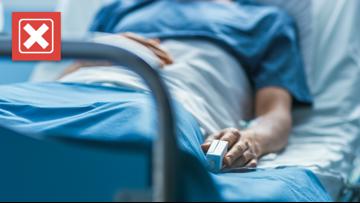Anyone who regularly visits the dentist has probably had their fair share of dental X-rays over the years. The dental staff drapes a lead apron over your chest, sometimes you have to bite down on a hard piece of plastic and then the dentist leaves you alone in the room while they’re taking your X-rays.
Dentists use dental X-rays to help identify cavities and other potential issues with your teeth. Much like other medical X-rays, dental X-rays rely on radiation to work. Some people worry about the potential for health risks that may be associated with that radiation.
Jennie texted VERIFY to ask about the frequency of dental X-rays, and if the X-rays can cause cancer.
THE QUESTION
Can dental X-rays cause cancer?
THE SOURCES
- American Dental Association (ADA)
- Food and Drug Administration (FDA)
- July 2020 literature review of low dose radiation risks published to the Journal of the National Cancer Institute
- Centers for Disease Control and Prevention (CDC)
- University of Michigan School of Dentistry
- Image Gently, a coalition of healthcare organizations dedicated to providing safe pediatric imaging worldwide
- National Library of Medicine’s MedlinePlus
- Oral Health Foundation
THE ANSWER
Dental X-rays, like all forms of radiation exposure, carry some risk of causing cancer. But dental organizations and public health experts say dental X-rays are generally safe in moderation and are an important part of maintaining oral health.
WHAT WE FOUND
We’re exposed to a little bit of radiation naturally every day, as was every human who came before us. The sun overhead and the minerals in the rocks and soil under our feet expose us to low doses of ionizing radiation. This is what’s called the “natural background radiation.”
A typical set of dental X-rays exposes people to about the same amount of radiation they’re exposed to in an average day from this natural background radiation.
Studies have found that even low doses of radiation from any source may increase your risk for cancer, but the risk from a single dental X-ray is small.
A July 2020 Journal of the National Cancer Institute review of 26 studies found clear evidence of excess cancer risk from many types of low-dose ionizing radiation. This includes natural background radiation, occupational exposures and medical exams, such as CT scans and X-rays.
The absolute risk of cancer from these sources will be small, the National Cancer Institute wrote of the review. But it said the presence of the risk reinforces that safety principle that radiation doses should be kept “as low as reasonably achievable.”
“Although we all are exposed to ionizing radiation every day, any added exposures, including from imaging procedures, slightly increases the risk of developing cancer later in life,” the Centers for Disease Control and Prevention (CDC) says.
Because of this, the Food and Drug Administration (FDA) and the American Dental Association (ADA) have guidelines for how dentists can keep radiation exposure “as low as reasonably achievable” for patients receiving X-rays. While these guidelines note that individual dentists can make the best judgments on their patients’ needs, they advise dentists to keep X-rays on healthy patients without tooth or jaw concerns to a minimum.
Depending on a patient’s history and current tooth health, the recommendations range from every six months to once every three years.
The University of Michigan School of Dentistry includes a chart on its website outlining the typical dose of radiation a person receives from various dental and medical X-rays. It compared those doses to the natural background radiation a person is exposed to on an average day. For some additional context, the school noted that a day of natural background radiation exposure is equivalent to the radiation exposure a passenger on a four-hour airline flight experiences.
While there are a number of different types of dental X-rays, a routine dental exam will usually require intraoral X-rays, which are X-rays inside of your mouth. The University of Michigan lists two types of intraoral X-rays on its chart: a series of four bitewings and a full mouth series.
- Four bitewings: equivalent to one day of natural background radiation
- Full mouth series: equivalent to about four days of natural background radiation
- Single view chest X-ray: equivalent to up to one day of natural background radiation
- Head CT scan: equivalent to up to eight months of natural background radiation
- Abdominal CT scan: equivalent to up to 20 months of natural background radiation
“The risk from a single dental X-ray picture is very small,” Image Gently, a coalition of healthcare organizations dedicated to providing safe pediatric imaging worldwide, says. “However, some studies do show a slight increase in cancer risk, even at low levels of radiation exposure, particularly in children. To be safe, we should act as if low doses of radiation may cause harm.”
Image Gently’s view is also shared by the University of Michigan School of Dentistry, the National Library of Medicine’s MedlinePlus, the Oral Health Foundation and the American Dental Association.
The Oral Health Foundation says you should tell your dental team if you are pregnant so they can take extra care to limit or avoid X-raying you. MedlinePlus says pregnant people should not have X-rays taken unless necessary.
X-rays are useful tools for dentists trying to detect damage and disease not visible during a regular dental exam, the ADA says.
Many dentists run annual bitewing X-rays on patients to look for early development of cavities they otherwise couldn’t see, MedlinePlus says. Dental X-rays can also help dentists look for damage and a number of other problems in both your teeth and jaw bones, or how they fit together.
If you have any concerns about X-rays, their safety and/or the frequency you receive them, you should talk to your dentist to work out dental treatment and prevention plans that work best for you.












